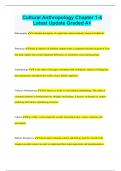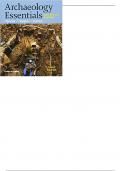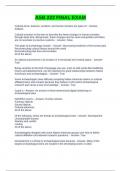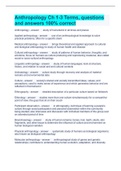Digital archaeology - Study guides, Class notes & Summaries
Looking for the best study guides, study notes and summaries about Digital archaeology? On this page you'll find 21 study documents about Digital archaeology.
All 21 results
Sort by

-
Digital Archaeology The Art and Science of Digital Forensics, 1st edition by Michael W Graves
- Exam (elaborations) • 66 pages • 2024
-
- $17.99
- + learn more
Chapter 1: The Anatomy of a Digital Investigation Chapter 2: Laws Affecting Forensic Investigations Chapter 3: Search Warrants and Subpoenas Chapter 4: Legislated Privacy Concerns Chapter 5: The Admissibility of Evidence Chapter 6: First Response and the Digital Investigator Chapter 7: Data Acquisition Chapter 8: Finding Lost Files Chapter 9: Document Analysis Chapter 10: E-mail Forensics Chapter 11: Web Forensics Chapter 12: Searching the Network Chapter 13: Excavating a Cloud Ch...

-
Cultural Anthropology Chapter 1-4 Latest Update Graded A+
- Exam (elaborations) • 11 pages • 2023
- Available in package deal
-
- $9.99
- + learn more
Cultural Anthropology Chapter 1-4 Latest Update Graded A+ Ethnography A detailed description of a particular culture primarily based on fieldwork. Ethnology Study & Analysis of different cultures from a comparative/historical point of view that help explain why certain important differences or similarities occur among groups. Anthropology It is the study of all aspects of human kind, biological, cultural, and linguistic, past and present, throughout the world, using a holistic approach. Cultu...

-
World Scholar's Cup 2024 - Booster Pack Questions And Answers Well Illustrated.
- Exam (elaborations) • 26 pages • 2024
-
- $14.49
- + learn more
World Scholar's Cup 2024 - Booster Pack Questions And Answers Well Illustrated. Jan Simek - correct answer. A professor from the University of Tennessee who, along with his colleagues, published images of giant glyphs carved into the mud surface of a cave in Alabama in the journal Antiquity. The glyphs depicted human forms and animals, and are some of the largest known cave images found in North America. The forms may represent spirits of the underworld, or other sacred creatu...

-
WSC Latest Update Graded A+
- Exam (elaborations) • 6 pages • 2023
-
Available in package deal
-
- $9.99
- + learn more
WSC Latest Update Graded A+ Extinction A term that typically describes a species that no longer has any known living individuals. de-extinction the process of reviving extinct species genetic engineering Process of making changes in the DNA code of living organisms Cloning A process in which a cell, cell product, or organism is copied from an original source. genome editing an experimental method of detecting and correcting defective genes in an individual back breeding A form of breeding w...

-
ARCHAEOLOGY ESSENTIALS THEORIES, METHODS, AND PRACTICE 3RD BY COLIN - Test Bank
- Exam (elaborations) • 89 pages • 2023
-
- $22.82
- + learn more
Chapter 3 Questions 1. Before any archaeological fieldwork begins, archaeologists try to make their objectives explicit in the form of a/an a) academic publication b) research design c) doctoral dissertation d) typology e) assemblage 2. Some survey techniques use squares when conducting regional surveys, but ________ are easier to locate and walk along, in order to record artifact densities across the landscape a) transects b) circles c) triangles d) parabolas e) none of the abo...

-
ASB 222 FINAL EXAM QUESTIONS AND ANSWERS
- Exam (elaborations) • 4 pages • 2024
-
- $11.49
- + learn more
ASB 222 FINAL EXAM Cultural items, features, ecofacts, and human remains are types of: - Answer- Artifacts Cultural evolution is the term to describe the linear changes in human societies through deep time. Being linear, these changes are the same everywhere and there are no reversals to previous systems. - Answer- False The goals of archaeology include: - Answer- Discovering evidence of the human past Reconstructing cultural history around the world Reconstructing past lives and soci...

-
Forensic science fields (All answered)
- Exam (elaborations) • 2 pages • 2024
-
Available in package deal
-
- $10.69
- + learn more
odontology correct answers in forensics, examination of bite marks and dental identification of corpses. Toxicology correct answers study of poisonous substances and their effects upon body parts forensic science correct answers The application of scientific knowledge to questions of civil and criminal law. forensic pathologist correct answers Medical doctor that primarily does autopsies and determines cause of death forensic scientist correct answers investigates crimes by collectin...

-
Anthropology Ch 1-3 Terms, questions and answers 100% correct
- Exam (elaborations) • 22 pages • 2023
-
Available in package deal
-
- $19.99
- + learn more
Anthropology Ch 1-3 Terms, questions and answers 100% correct Anthropology study of humankind in all times and places Applied anthropology use of an anthropological knowledge to solve practical problems; often for a specific client Medical anthropology brings theoretical and applied approach to cultural and biological anthropology to study of human health and disease Cultural anthropology study of patterns of human behavior, thoughts, and emotions; focus on humans as cu...

-
ASB 222 Final Exam
- Exam (elaborations) • 4 pages • 2024
-
- $8.49
- + learn more
Cultural items, features, ecofacts, and human remains are types of: - answer-Artifacts Cultural evolution is the term to describe the linear changes in human societies through deep time. Being linear, these changes are the same everywhere and there are no reversals to previous systems. - answer-False The goals of archaeology include: - answer-Discovering evidence of the human past Reconstructing cultural history around the world Reconstructing past lives and societies All of the above ...

-
A Mini Travelogue for English Language Writing Skills | Sample Answer for Class & Ready To Teach
- Presentation • 2 pages • 2023
-
- $3.90
- + learn more
In this digital PDF, readers will discover the beauty and magnificence of Machu Picchu, an ancient Inca city located in Peru, South America. The travelogue provides a vivid and descriptive account of the author’s personal experience visiting this awe-inspiring site. This PDF is suitable for readers aged 12 and above and is perfect for those who love history, archaeology, and travel. The teaching duration is approximately 30 mins, allowing ample time for discussions, reflections, and follow-...

That summary you just bought made someone very happy. Also get paid weekly? Sell your study resources on Stuvia! Discover all about earning on Stuvia


